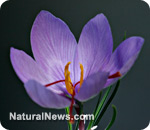
(NaturalNews) Age-related macular degeneration (ARMD) is the primary cause of older age onset partial or sometimes total blindness. Although most common in adults over 50, macular degeneration can occur at any age, though rarely among those under 50.
Macular degeneration mostly affects central vision, forcing people to rely more on less distinct peripheral vision to recognize objects and faces. The macula occupies a small portion of the retina in the back of the eye.
Though small, the macula is the most light sensitive area of the retina, and it permits detailed focus of objects located centrally in the field of vision. There are two classifications of macular degeneration: Dry and wet.
Dry macular degeneration is the most common and least severe. Diminished central vision clarity occurs gradually. It's called dry because there is no capillary leakage in that region of the eye. Wet macular degeneration does involve retina capillary leakage. It's symptoms are usually more severe and worsen rapidly.
Thus far, ophthalmology has little to offer as a remedy for macular degeneration. But ophthalmologists do recommend taking leutin and astaxanthin to slow ARMD's progress or possibly reverse it slightly.
However, recent human clinical research in Italy and Australia has discovered a non-pharmaceutical approach that proved efficacious for improving eyesight with macular degeneration sufferers safely. It is a little pricey though. It's the spice known as saffron.
Saffron is pricier than most other spices because the bulbs must be planted by hand, and the three crimson stigmas or saffron threads have to also be plucked out of each flower by hand.
The Australian clinical trial
The Australian human study was conducted by Sydney University Professor of Neurology Jonathan Stone. Both this study and the Italian research were similar in scope and dosage. And both conducted a more humane approach to double blind placebo studies with a non-toxic remedy than normally.
The study involved 25 macular degeneration sufferers. Instead of depriving a placebo group from a product that could do something for their ailment, the study switched placebo subjects with saffron subjects half-way through the trial unbeknownst to all involved. The daily dosage was 20 mg of saffron.
The whole study was six months long, so each side of the 25 double blind subjects had three months of improved vision with three months of impaired vision. All 25 were tested for neuron electrical conductivity in the macula and retina, and 23 showed significant improvement. Those 23 also reported they could see much better.
Visual improvement began after only two weeks on saffron. When the saffron group was put onto placebos, they complained that their improved eyesight had begun diminishing again. Conversely, those on placebos for the first half of the trial began seeing better after three months of no improvement.
Professor Stone projects that after a year or more ingesting only 20 mg (milligrams) of saffron daily, vision improvements should stabilize without requiring more saffron dosing.
Stone doesn't know exactly how or why, but he became aware that saffron influences the neuron's genetic code to restore its capacity for healing and protecting neuron cells. Neurons are responsible for transmitting electrical signals or impulses throughout the nervous system.
Professor Stone is looking forward to completing animal studies with saffron for other neurological issues like Parkinson's and Alzheimer's. Then those would go into human clinical trials also.
His results, combined with the Italian study, impressed Professor Stone enough to create his own line of saffron capsules for the market. He qualified it as a safe nutraceutical that shouldn't require any more testing for FDA approval.
Don't mention that it cures macular degeneration and you'll stay out of trouble, mate. Just say it supports eye health (wink).
Sources for this article include:
Data: 19.02.2013
Learn more:
Nenhum comentário:
Postar um comentário